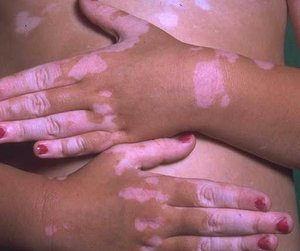Natta R, Somsak T, Wisuttida T, Laor L. J Am Acad Dermatol 2003 Sep: 49(3):473-6
The authors' objective was to assess the efficacy of NB-UVB in patients with vitiligo who did not respond either to topical therapy or to oral psoralen plus ultraviolet A (PUVA). This was a retrospective analysis of patients with vitiligo who were treated with NB-UVB from February 1998 to January 2001. They received NB-UVB treatment 2 times per week. The dose was increased by 10% to 20% per treatment for 20 treatments. The dose was then increased by 2% to 5% per treatment until 50% repigmentation was observed or persistent erythema developed. The treatment was considered a failure and terminated if the patient showed less than 25% improvement after 40 to 50 exposures, The cohort included 60 patients: 22 men and 38 women, aged 11 to 61 years, with localized-generalized vitiligo. All cases had been previously treated with topical steroid with or without topical psoralen with solar light exposure. The authors concluded that NB-UVB treatment in 25 of 60 patients (42%) achieved more than 50% repigmentation on face, trunk, arms, and legs. The hand and foot lesions showed less than 25% repigmentation in all cases and there was no significant difference between the responders and non-responders in age, sex, duration of diseases, and skin type. The response rate of patients who had not been previously treated with PUVA was significantly higher than that of patients who had been previously treated with PUVA (67% vs. 36%). This study demonstrates that NB-UVB is effective in repigmentation of vitiligo patients, and patients previously treated with PUVA are less responsive than those who have not had PUVA. The face, trunk, and proximal extremities were repigmented more than other sites of the body.
JDD ARTICLE EVALUATION
Current treatment modalities for vitiligo include PUVA therapy, narrow-band UVB therapy, topical corticosteroids, depigmentation therapy with monobenzylether of hydroquinone, and surgical treatments (minigrafting, thin split-thickness grafting, suction blister grafting, micropigmentation). The use of lasers, vitamin D analogues, tacrolimus, depigmentation with Q-switched ruby laser, and grafting of cultured melanocytes are newer techniques that offer promising results. More interesting is the use of NB UVB with tacrolimus or vitamin D analogues, yet repigmentation is reached more on the face, trunk, and proximal extremities. These are the same sites as with NB-UVB alone, but it seems that the addition of topicals to NB-UVB shortens the time to repigmentation. In my experience, steroids work better on proximal extremities than tacrolimus does. At the moment the NYU department of dermatology is conducting a double-blinded randomized study of Elidel[R] (Pimecrolimus cream 1%, Novartis Pharmaceuticals Corp.) vs. calcipotriol. The purpose is to evaluate steroid-sparing therapies for vitiligo; preliminary results are promising with both cohorts. In conclusion, many therapies exist for the treatment of vitiligo, but topicals in addition to NB-UVB are promising and seem to be better than either alone.
COPYRIGHT 2003 Journal of Drugs in Dermatology
COPYRIGHT 2004 Gale Group




